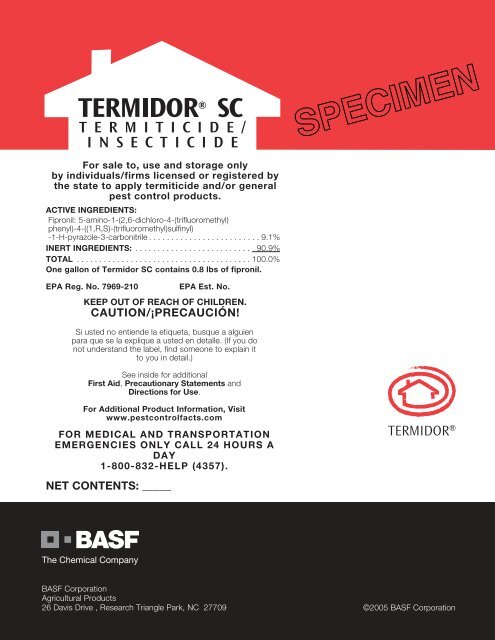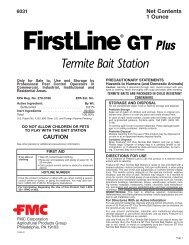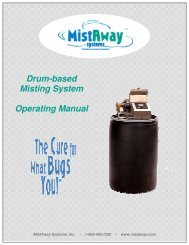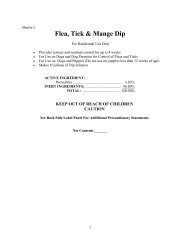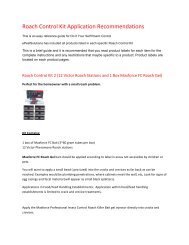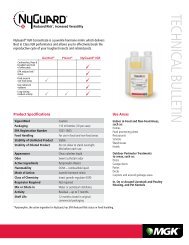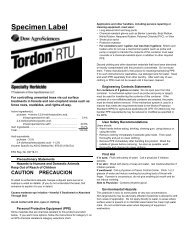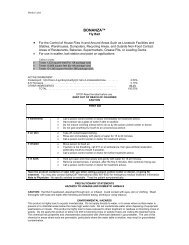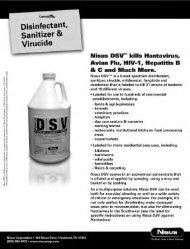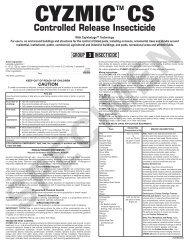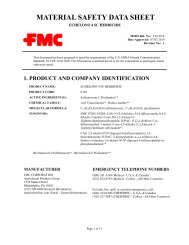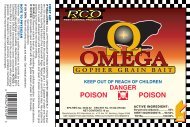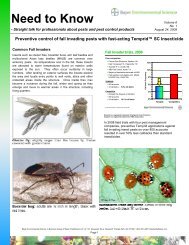Termidor SC - McGrath Pest Control
Termidor SC - McGrath Pest Control
Termidor SC - McGrath Pest Control
Create successful ePaper yourself
Turn your PDF publications into a flip-book with our unique Google optimized e-Paper software.
For sale to, use and storage only<br />
by individuals/firms licensed or registered by<br />
the state to apply termiticide and/or general<br />
pest control products.<br />
ACTIVE INGREDIENTS:<br />
Fipronil: 5-amino-1-(2,6-dichloro-4-(trifluoromethyl)<br />
phenyl)-4-((1,R,S)-(trifluoromethyl)sulfinyl)<br />
-1-H-pyrazole-3-carbonitrile . . . . . . . . . . . . . . . . . . . . . . . . . 9.1%<br />
INERT INGREDIENTS: . . . . . . . . . . . . . . . . . . . . . . . . . . 90.9%<br />
TOTAL . . . . . . . . . . . . . . . . . . . . . . . . . . . . . . . . . . . . . . . 100.0%<br />
One gallon of <strong>Termidor</strong> <strong>SC</strong> contains 0.8 lbs of fipronil.<br />
EPA Reg. No. 7969-210<br />
EPA Est. No.<br />
KEEP OUT OF REACH OF CHILDREN.<br />
CAUTION/¡PRECAUCIÓN!<br />
Si usted no entiende la etiqueta, busque a alguien<br />
para que se la explique a usted en detalle. (If you do<br />
not understand the label, find someone to explain it<br />
to you in detail.)<br />
See inside for additional<br />
First Aid, Precautionary Statements and<br />
Directions for Use.<br />
For Additional Product Information, Visit<br />
www.pestcontrolfacts.com<br />
FOR MEDICAL AND TRANSPORTATION<br />
EMERGENCIES ONLY CALL 24 HOURS A<br />
DAY<br />
1-800-832-HELP (4357).<br />
NET CONTENTS: _____<br />
BASF Corporation<br />
Agricultural Products<br />
26 Davis Drive , Research Triangle Park, NC 27709 ©2005 BASF Corporation
IF SWALLOWED<br />
IF ON SKIN OR<br />
CLOTHING<br />
FIRST AID<br />
• Call a poison control center or doctor immediately for treatment advice.<br />
• Have a person sip a glass of water if able to swallow.<br />
• Do not induce vomiting unless told to by a poison control center or doctor.<br />
• Do not give anything by mouth to unconscious person.<br />
• Take off contaminated clothing.<br />
• Rinse skin immediately with plenty of water for 15-20 minutes.<br />
• Call a poison control center or doctor for treatment advice.<br />
IF INHALED<br />
IF IN EYES<br />
• Move person to fresh air.<br />
• If person is not breathing, call 911 or ambulance, then give artificial respiration, preferably mouth to<br />
mouth if possible.<br />
• Call a poison control center or doctor for treatment advice.<br />
• Hold eye open and rinse slowly and gently with water for 15-20 minutes. Remove contact lenses, if present,<br />
after the first 5 minutes, then continue rinsing eye.<br />
• Call a poison control center or doctor for treatment advice.<br />
Have the product container or label with you when calling a poison control center or doctor, or going for treatment.<br />
NOTE TO PHYSICIAN: There is no specific antidote. All treatment should be based on observed signs and symptoms of distress in<br />
the patient. Overexposure to materials other than this product may have occurred. In severe cases of overexposure by oral ingestion,<br />
lethargy, muscle tremors, and in extreme cases, possibly convulsions may occur.<br />
PRECAUTIONARY STATEMENTS<br />
HAZARDS TO HUMANS<br />
AND DOMESTIC ANIMALS<br />
CAUTION<br />
Harmful if swallowed, absorbed through skin or inhaled.<br />
Causes eye irritation. Do not get in eyes, on skin or on<br />
clothing. Do not breathe spray mist.<br />
PERSONAL PROTECTIVE EQUIPMENT<br />
(PPE)<br />
All pesticide handlers (mixers, loaders, and applicators)<br />
must wear long-sleeved shirt and long pants,<br />
socks, shoes, and chemical-resistant gloves. All pesticide<br />
handlers must wear a dust/mist filtering respirator<br />
(MSHA/NIOSH approval number prefix TC-21C)<br />
when working in a non-ventilated space, including but<br />
not limited to crawl-spaces and basements. All pesticide<br />
handlers must wear protective eyewear (goggles,<br />
a faceshield, or safety glasses with front, brow, and<br />
temple protection) when working in a non-ventilated<br />
space, including but not limited to crawl-spaces and<br />
basements or when applying termiticide by rodding or<br />
sub-slab injection.<br />
USER SAFETY RECOMMENDATIONS<br />
Users should wash hands thoroughly with soap and water<br />
before eating, drinking, chewing gum, using tobacco or using<br />
the toilet.<br />
Remove contaminated clothing. Then wash body thoroughly<br />
with soap and water and put on clean clothing. Wash clothing<br />
with detergent and hot water before reusing.<br />
Remove PPE immediately after handling this product. Wash<br />
outside of gloves before removing. Wash PPE before reusing.<br />
ENVIRONMENTAL HAZARDS<br />
This pesticide is toxic to birds, fish, and aquatic invertebrates.<br />
Do not apply directly to water, or to areas<br />
where surface water is present or to intertidal areas<br />
below the mean high water mark. Runoff from treated<br />
areas may be hazardous to aquatic organisms in<br />
neighboring areas. Care must be taken to avoid<br />
runoff. Do not contaminate water by cleaning equipment<br />
or disposal of wastes. Do not contaminate water<br />
when disposing of equipment washwaters.<br />
DIRECTIONS FOR USE<br />
It is a violation of Federal law to use this product in a<br />
manner inconsistent with its labeling.<br />
Read entire label before using this product.<br />
For sale to, use and storage only by individuals/firms<br />
licensed or registered by the state to apply termiticide<br />
and/or general pest control products. States may have<br />
more restrictive requirements regarding qualifications<br />
of persons using this product. Consult the<br />
structural pest control regulatory agency of your<br />
state prior to use of this product.<br />
STORAGE AND DISPOSAL<br />
Do not contaminate water, food, or feed by storage or<br />
disposal.<br />
STORAGE<br />
Store unused product in original container only, out of<br />
reach of children and animals.<br />
PESTICIDE DISPOSAL<br />
<strong>Pest</strong>icide wastes are acutely hazardous. Improper<br />
disposal of excess pesticide is a violation of Federal<br />
law. If these wastes cannot be disposed of by use<br />
according to label instructions, contact your State<br />
<strong>Pest</strong>icide or Environmental <strong>Control</strong> Agency, or the<br />
Hazardous Waste representative at the nearest EPA<br />
Regional Office for guidance.<br />
2
CONTAINER DISPOSAL<br />
Triple rinse (or equivalent). Then offer for recycling or<br />
reconditioning, or puncture and dispose of in a sanitary<br />
landfill, or incineration, or, if allowed by state or local<br />
authorities, by burning. If burned, stay out of smoke.<br />
In case of minor spills or leaks, soak up with sand,<br />
earth or other suitable material and dispose of as<br />
pesticide waste.<br />
GENERAL PRECAUTIONS<br />
• When treating adjacent to an existing structure,<br />
the applicator must check the area to be treated,<br />
and immediate adjacent areas of the structure,<br />
for visible and accessible cracks and holes<br />
to prevent any leaks or significant exposures to<br />
persons occupying the structure. People present<br />
or residing in the structure during application<br />
must be advised to remove their pets and<br />
themselves from the structure if they see any<br />
signs of leakage. After application, the applicator<br />
is required to check for leaks. All leaks<br />
resulting in the deposition of termiticide in locations<br />
other than those prescribed on this label<br />
must be cleaned up prior to leaving the application<br />
site. Do not allow people or pets to contact<br />
contaminated areas or to reoccupy contaminated<br />
areas of the structure until the clean up is<br />
completed.<br />
• Do not apply <strong>Termidor</strong> ® <strong>SC</strong> termiticide/insecticide<br />
in a way that will contact any other person.<br />
Only protected applicators wearing personal<br />
protective equipment as required by this product<br />
label may be in the area during application.<br />
• All holes in commonly occupied areas into which<br />
<strong>Termidor</strong> <strong>SC</strong> has been applied must be plugged.<br />
Plugs must be of a non-cellulose material or<br />
covered by an impervious, non-cellulose material.<br />
• Do not apply finished dilution of <strong>Termidor</strong> <strong>SC</strong><br />
until all heating/air conditioning ducts, air vents,<br />
plumbing pipes, sewer lines, floor drains, heating<br />
pipes and electrical lines/conduits are known<br />
and identified. Do not puncture or contaminate<br />
any of these.<br />
• Do not treat around any edible plants with<br />
<strong>Termidor</strong> <strong>SC</strong>.<br />
• Do not contaminate public and private water<br />
supplies.<br />
• Do not treat while precipitation is occurring.<br />
• Do not treat soil that is water-saturated or<br />
frozen.<br />
• Use anti-backflow equipment on all filling hoses.<br />
• Do not use in tanks with borate contaminants.<br />
GENERAL INFORMATION<br />
In order to maximize the termiticide potency of <strong>Termidor</strong><br />
<strong>SC</strong>, it should be applied in a manner to provide a continuous<br />
treated zone to prevent termites from attacking<br />
the wood to be protected. <strong>Termidor</strong> <strong>SC</strong> should only be<br />
applied by licensed technicians familiar with trenching,<br />
rodding, short rodding, subslab injection, low-pressure<br />
banded surface applications, and foam delivery techniques.<br />
<strong>Termidor</strong> <strong>SC</strong> is highly effective against a variety<br />
of subterranean termites including species of<br />
Reticulitermes, Zootermopsis, Heterotermes, and<br />
Coptotermes. While <strong>Termidor</strong> <strong>SC</strong> is labeled for use at<br />
0.06%, 0.09% or 0.125% finished dilution, the 0.06%<br />
finished dilution should be used for typical control situations.<br />
Where severe termite infestations occur, where<br />
problem soils occur or where difficult or problem construction<br />
types are encountered, it may be necessary<br />
to use either 0.09% or 0.125% <strong>Termidor</strong> <strong>SC</strong>.<br />
<strong>Termidor</strong> <strong>SC</strong> is formulated as a water-based suspension<br />
concentrate liquid containing 9.1% active ingredient.<br />
MIXING INSTRUCTIONS<br />
Mix <strong>Termidor</strong> <strong>SC</strong> in the following manner:<br />
1.Fill tank 1/4 to 1/3 full with water. Filling hose<br />
must be equipped with an anti-backflow device.<br />
2.Start pump to begin by-pass agitation and place<br />
end of treating tool in tank to allow circulation<br />
through hose.<br />
3.Add appropriate amount of <strong>Termidor</strong> <strong>SC</strong>. Refer<br />
to the table in the box below to determine the<br />
proper amount to add to desired gallons of<br />
water.<br />
4.Add remaining amount of water.<br />
5.Let pump run and allow recirculation through the<br />
hose for 2 to 3 minutes or longer, until<br />
<strong>Termidor</strong> <strong>SC</strong> in the tank has dispersed completely.<br />
To Mix 0.06% Desired<br />
Finished Dilution of<br />
<strong>Termidor</strong> <strong>SC</strong><br />
To Mix 0.09% Desired<br />
Finished Dilution of<br />
<strong>Termidor</strong> <strong>SC</strong><br />
To Mix 0.125% Desired<br />
Finished Dilution of<br />
<strong>Termidor</strong> <strong>SC</strong><br />
Start with<br />
(gallons<br />
of water)<br />
Start with<br />
(gallons<br />
of water)<br />
Start with<br />
(gallons<br />
of water)<br />
Add<br />
(fluid ounces of<br />
<strong>Termidor</strong> <strong>SC</strong>)<br />
100 gallons finished dilution 99.25 78 oz. (or 2 qt. + 14 oz.)<br />
50 gallons finished dilution 49.75 39 oz. (or 1 qt. + 7 oz.)<br />
25 gallons finished dilution 24.75 19 oz. (or 1 pt. + 3 oz.)<br />
1 gallon of finished dilution 1 0.8 oz.<br />
Add<br />
(fluid ounces of<br />
<strong>Termidor</strong> <strong>SC</strong>)<br />
100 gallons finished dilution 99 117 oz. (or 3 qt. + 21 oz.)<br />
50 gallons finished dilution 49.75 59 oz. (or 1 qt. + 27 oz.)<br />
25 gallons finished dilution 24.75 29 oz. (or 1 pt. + 13 oz.)<br />
1 gallon of finished dilution 1 1.2 oz.<br />
Add<br />
(fluid ounces of<br />
<strong>Termidor</strong> <strong>SC</strong>)<br />
100 gallons finished dilution 98 156 oz. (or 1 gal. + 28 oz.)<br />
50 gallons finished dilution 49.75 78 oz. (or 2 qt. + 14 oz.)<br />
25 gallons finished dilution 24.75 39 oz. (or 1 qt. + 7 oz.)<br />
1 gallon of finished dilution 1 1.6 oz.<br />
APPLICATION VOLUME<br />
To provide maximum control and protection against termite<br />
infestation, apply the volumes of <strong>Termidor</strong> <strong>SC</strong> finished<br />
dilution specified in the DIRECTIONS FOR USE<br />
3
throughout this label. However, if the soil will not accept<br />
these labeled volumes of <strong>Termidor</strong> ® <strong>SC</strong><br />
termiticide/insecticide, twice the concentration of<br />
<strong>Termidor</strong> <strong>SC</strong> may be applied in half the volume of finished<br />
dilution. For example, if 0.06% <strong>Termidor</strong> <strong>SC</strong> cannot<br />
be applied to achieve 4 gallons finished dilution per<br />
10 linear feet per foot of depth, then 0.125% <strong>Termidor</strong><br />
<strong>SC</strong> applied in 2 gallons finished dilution per 10 linear feet<br />
per foot of depth may be substituted. These APPLICA-<br />
TION VOLUME instructions do not ever apply to ground<br />
that is water-saturated or frozen. Do not treat while precipitation<br />
is occuring. Do not treat soil that is water-saturated<br />
or frozen or in any conditions where runoff or<br />
movement from the treatment area (site) is likely to occur.<br />
NOTE: Large reductions of application volume reduce<br />
the ability to obtain a continuous treated zone. Variance is<br />
allowed when volume and concentration are consistent<br />
with label-directed rates and a continuous treated zone is<br />
still achieved. At reduced application volume, it may be<br />
necessary for the applicator to drill holes closer than 12<br />
inches apart to create a continuous treated zone.<br />
PRE-CONSTRUCTION TREATMENT<br />
DO NOT APPLY AT A DOSAGE AND/OR CONCENTRA-<br />
TION LOWER THAN TERMIDOR <strong>SC</strong> AT 0.06% FOR<br />
APPLICATIONS UP TO AND INCLUDING INSTALLATION<br />
OF THE FINAL GRADE. Prior to each application, applicators<br />
must notify the general contractor, construction<br />
superintendent, or similar responsible party, of the intended<br />
<strong>Termidor</strong> <strong>SC</strong> application and intended sites of application<br />
and instruct the responsible person to notify<br />
construction workers and other on site individuals to<br />
leave the treatment area and not return until <strong>Termidor</strong><br />
<strong>SC</strong> has been absorbed into the soil.<br />
GENERAL<br />
Pre-construction treatments are defined to include treatments<br />
made during all phases of construction up to and<br />
including installation of the final grade. Effective pre-construction<br />
termite control is achieved by establishing a<br />
thorough and complete horizontal or vertical treated zone<br />
using 0.06%, 0.09% or 0.125% <strong>Termidor</strong> <strong>SC</strong>.<br />
When treating foundations deeper than 4 feet, apply the<br />
termiticide as the backfill is being replaced, or, if the construction<br />
contractor fails to notify the applicator to permit<br />
this, treat the foundation to a minimum depth of 4 feet<br />
after the backfill has been installed. The applicator must<br />
trench and rod into the trench or trench along the foundation<br />
walls and around pillars and other foundation elements,<br />
at the rate prescribed from grade to a minimum<br />
depth of 4 feet. When the top of the footing is exposed,<br />
the applicator must treat the soil adjacent to the footing<br />
to a depth not to exceed the bottom of the footing.<br />
However, in no case should a structure be treated below<br />
the footing.<br />
CONCRETE SLAB (INCLUDING MONO-<br />
LITHIC, FLOATING AND SUPPORTED CON-<br />
CRETE SLABS) ON GROUND OR IN<br />
BASEMENTS<br />
HORIZONTAL TREATED ZONES<br />
Apply an overall treatment of <strong>Termidor</strong> <strong>SC</strong> to the entire<br />
surface to be covered beneath the concrete slab. This<br />
includes the slab under the actual living area, plus carports,<br />
porches, basement floors, and any extended<br />
entrances. Make this treatment at the rate of 1-1.5 gallons<br />
finished dilution per 10 square feet. Make these<br />
applications using a coarse spray nozzle and low-pressure<br />
spray (less than 25 p.s.i.), spraying the dilution evenly<br />
and uniformly over the entire area treated.<br />
VERTICAL TREATED ZONES<br />
Apply <strong>Termidor</strong> <strong>SC</strong> at rate of 1 gallon finished<br />
dilution/square foot around anything penetrating the slab<br />
(e.g. utility services, plumbing lines) and at 4 gallons of<br />
finished dilution per 10 linear feet per foot of depth along<br />
the inside and outside perimeter of foundation walls. The<br />
applicator must trench and rod into the trench or trench<br />
along the foundation walls and around pillars and other<br />
foundation elements. Make this treatment along the inside<br />
of foundation walls at the rate of 4 gallons finished dilution<br />
(0.06%, 0.09% or 0.125% <strong>Termidor</strong> <strong>SC</strong>) per 10 linear<br />
feet per foot of depth, or if the footing is more than 4 feet<br />
below grade, to a minimum depth of 4 feet below grade.<br />
A trench need not be wider than six inches. Low-pressure<br />
spray (less than 25 p.s.i. at the nozzle) may be used to<br />
treat soil which will be replaced in the trench. When rodding<br />
from grade or from the bottom of a shallow trench,<br />
rod holes should be spaced in a manner that will allow for<br />
application of a continuous treated zone, but not wider<br />
than 12 inches apart. Rod holes should not extend below<br />
the top of the footing. These two applications, horizontal<br />
treated zone (overall treatment 1-1.5 gallons/10 square<br />
feet) and vertical treated zone (the additional treatment of<br />
4 gallons/10 linear feet) should be made prior to covering<br />
area with the concrete slab. If the slab is not to be<br />
poured the same day as treatment, cover the treated soil<br />
with a waterproof barrier such as polyethylene sheeting.<br />
After completion of the grading, apply <strong>Termidor</strong> <strong>SC</strong> by<br />
trenching and rodding into the trench or trenching alone<br />
along the slab or foundation perimeter at the rate of 4<br />
gallons finished dilution (0.06%, 0.09% or 0.125%<br />
<strong>Termidor</strong> <strong>SC</strong> ) per 10 linear feet per foot of depth, or if<br />
the footing is more than 4 feet below grade, to a minimum<br />
depth of 4 feet. Trenches must be a minimum of 6<br />
inches deep or to the bottom of the footing and need not<br />
be wider than 6 inches. When trenching in sloping (tiered)<br />
soil, the trench must be stepped to ensure adequate distribution<br />
and to prevent <strong>Termidor</strong> <strong>SC</strong> from running out<br />
of the trench. The finished dilution (0.06%, 0.09% or<br />
0.125% <strong>Termidor</strong> <strong>SC</strong> ) should be mixed with the soil as<br />
it is replaced in the trench. Rod holes must be spaced so<br />
as to achieve a continuous treated zone but in no case<br />
more than 12 inches apart. However, in no case should<br />
the structure be treated below the footing.<br />
CRAWL SPACES<br />
For crawl spaces, apply vertical termiticide treatment at<br />
the rate of 4 gallons of finished dilution (0.06%, 0.09% or<br />
0.125% <strong>Termidor</strong> <strong>SC</strong>) per 10 linear feet per foot of<br />
depth from grade to the top of the footing, or if the footing<br />
is more than 4 feet below grade, to a minimum depth<br />
of 4 feet. Apply by trenching and rodding into the trench,<br />
or trenching. Treat both sides of foundation and all piers<br />
and pipes. When the top of the footing is exposed, the<br />
applicator must treat the soil adjacent to the footing to a<br />
depth not to exceed the bottom of the footing.<br />
4
• Rod holes and trenches must not extend below the<br />
bottom of the footing.<br />
• Rod holes must be spaced so as to achieve a continuous<br />
treated zone but in no case more than 12<br />
inches apart.<br />
• Trenches must be a minimum of 6 inches deep or<br />
to the bottom of the footing, whichever is less, and<br />
need not be wider than 6 inches. When trenching in<br />
sloping (tiered) soil, the trench must be stepped to<br />
ensure adequate distribution and to prevent termiticide<br />
from running off. The finished dilution must be<br />
mixed with soil as it is replaced in the trench.<br />
HOLLOW BLOCK FOUNDATIONS/VOIDS<br />
Hollow block foundations or voids in masonry resting<br />
atop the footing may be treated in order to create a continuous<br />
treatment zone in the area to be treated.<br />
Applicators may drill and treat into voids of masonry elements<br />
if not openly accessible. Apply at the rate of 2 gallons<br />
of finished dilution per 10 linear feet of footing using<br />
a nozzle pressure of 25 p.s.i. or less. When using this<br />
treatment, access holes may be drilled below the sill plate<br />
and should be as close as possible to the footing as is<br />
practical. Treatment of voids in block or rubble foundation<br />
walls must be closely examined: Applicators must inspect<br />
areas of possible runoff as a precaution against application<br />
leakage in the treated areas. Some areas may not be<br />
treatable or may require mechanical alteration prior to<br />
treatment.<br />
All leaks resulting in the deposition of <strong>Termidor</strong> ® <strong>SC</strong> termiticide/insecticide<br />
in locations other than those prescribed<br />
on this label must be cleaned up prior to leaving<br />
the application site. Do not allow people or pets to contact<br />
contaminated areas or to reoccupy the contaminated<br />
areas of the structure until the clean up is completed.<br />
Not for use in voids insulated with rigid foam.<br />
POST-CONSTRUCTION CONVENTIONAL<br />
STRUCTURAL TERMITE TREATMENT<br />
GENERAL<br />
For applications made after the final grade is installed, the<br />
applicator must trench and rod into the trench or trench<br />
along the foundation walls and around pillars and other<br />
foundation elements, at either 0.06%, 0.09% or 0.125%<br />
<strong>Termidor</strong> <strong>SC</strong> from grade to the top of the footing. When<br />
the footing is more than four (4) feet below grade, the<br />
applicator must trench and rod into the trench or trench<br />
along the foundation walls, at either 0.06%, 0.09% or<br />
0.125% <strong>Termidor</strong> <strong>SC</strong>, to a minimum depth of four feet.<br />
The actual depth of treatment will vary depending on soil<br />
type, degree of compaction, and location of termite activity.<br />
When the top of the footing is exposed, the applicator<br />
must treat the soil adjacent to the footing to a depth not<br />
to exceed the bottom of the footing. However, in no case<br />
should a structure be treated below the footing.<br />
Do not apply finished dilution (0.06%, 0.09% or 0.125%<br />
<strong>Termidor</strong> <strong>SC</strong>) until the location and type of (1) construction<br />
of heat or air-conditioning ducts and vents, (2) water<br />
and sewer (or plumbing) lines and (3) electrical lines/conduits<br />
are known and identified. Caution must be taken to<br />
avoid contamination of and damage to these structural<br />
elements and airways.<br />
CONCRETE SLAB OVER SOIL (INCLUDING<br />
MONOLITHIC, FLOATING AND SUPPORT-<br />
ED CONCRETE SLABS)<br />
EXTERIOR PERIMETER<br />
Apply by trenching and rodding into the trench or<br />
trenching along the foundation at the rate of 4 gallons<br />
finished dilution (0.06%, 0.09% or 0.125% <strong>Termidor</strong><br />
<strong>SC</strong>) per 10 linear feet per foot of depth, or, if the footing<br />
is more than 4 feet below grade, to a minimum<br />
depth of 4 feet. Trenches must be a minimum of 6<br />
inches deep or to the bottom of the footing and need<br />
not be wider than 6 inches. The finished dilution<br />
(0.06%, 0.09% or 0.125% <strong>Termidor</strong> <strong>SC</strong>) should be<br />
mixed with the soil as it is replaced in the trench. Rod<br />
holes must be spaced so as to achieve a continuous<br />
treated zone but in no case more than 12 inches apart.<br />
However, in no case should the structure be treated<br />
below the footing.<br />
SUB-SLAB INJECTION<br />
Sub-slab injection treatments can be made from inside<br />
the structure or in cases when this is not possible, by<br />
drilling through the foundation from the outside as directed<br />
below. Prior to making any treatments, locate all heating/air<br />
conditioning ducts, vents, water/sewer lines, and<br />
electrical lines/conduits.<br />
Vertical Drilling/Injection: To treat under the slab,<br />
drill vertically through the slab along the interior<br />
perimeter of the foundation including the garage. Drill<br />
holes along all concrete expansion joints, cracks,<br />
plumbing, and utility services penetrating the slab. It<br />
may be necessary to drill holes along one side of the<br />
slab adjacent to an interior partition wall if there is<br />
clear evidence of termite activity or damage in the<br />
wall. All drill-holes through the slab should be spaced<br />
so as to achieve a continuous treated zone but in no<br />
case be more than 12 inches apart. Inject a 0.06%,<br />
0.09% or 0.125% dilution of <strong>Termidor</strong> <strong>SC</strong> into the<br />
drilled holes at the rate of 4 gallons per 10 linear feet<br />
per foot of depth. For best results, application should<br />
be made with a lateral dispersal nozzle. All holes in<br />
commonly occupied areas into which material has<br />
been applied must be plugged. Plugs must be of a<br />
non-cellulose material or covered by an impervious,<br />
non-cellulose material.<br />
Horizontal Drilling/Rodding/Sub-slab Injection<br />
from the Exterior of the Foundation: This technique<br />
should be used to treat underneath the slab<br />
only when floors or interior design do not allow for<br />
vertical drilling. Care must be exercised not to rod<br />
into heating ducts, water/sewer lines, and electrical<br />
lines/conduits. Horizontal short-rodding practices<br />
can be used to establish a continuous treated zone<br />
along the inside perimeter of the foundation. Holes<br />
should be drilled from outside the foundation at an<br />
angle which allows a finished dilution (0.06%, 0.09%<br />
or 0.125%) of <strong>Termidor</strong> <strong>SC</strong> to be deposited below<br />
heating ducts, water/sewer lines, and electrical conduits<br />
if present. Horizontal long rodding practices<br />
may only be employed to treat areas underneath the<br />
slab that are not accessible by vertical rodding or<br />
horizontal short rodding. Long rods exceeding 20<br />
feet should not be used. For all horizontal rodding<br />
applications, all drill holes through the foundation<br />
5
should be spaced so as to achieve a continuous<br />
treated zone but in no case be more than 12 inches<br />
apart. Inject a 0.06%, 0.09% or 0.125% dilution of<br />
<strong>Termidor</strong> ® <strong>SC</strong> termiticide/insecticide into the drilled<br />
holes at the rate of 4 gallons per 10 linear feet per<br />
foot of depth. For best results, make applications<br />
with a lateral dispersal nozzle. All holes must be<br />
plugged. Plugs must be of a non-cellulose material<br />
or covered by an impervious, non-cellulose material.<br />
Bath Traps: Exposed soil or soil covered with tar or<br />
similar sealant beneath or around plumbing and/or<br />
drain pipe entry areas should be treated with a minimum<br />
of 1 gallon but no more than 4 gallons of finished<br />
dilution per square foot. An access door or<br />
inspection vent should be cut and installed, if not<br />
already present. After inspection and removal of all<br />
wood/cellulose debris, the soil can be treated by rodding<br />
or drenching the soil with a 0.06%, 0.09% or<br />
0.125% dilution of <strong>Termidor</strong> <strong>SC</strong>.<br />
STRUCTURES WITH FRENCH DRAINS<br />
AND SUMP PUMPS<br />
French drains eliminate water at the footer along a<br />
foundation perimeter. They are common in hollow<br />
block foundation structures to drain water seeping<br />
from the exterior perimeter or underneath the foundation.<br />
Soil must be dry before applying to sites with<br />
French drains. Do not treat soil that is saturated or<br />
frozen. Do not apply when precipitation is likely to<br />
occur. Do not rod through the slab any closer than 24<br />
inches to the French drain to prevent finished dilution<br />
seepage and/or damage to the drain or the tiles. Do<br />
not apply <strong>Termidor</strong> <strong>SC</strong> within 5 feet of the sump<br />
pump pit and pump. Do not drill through hollow block<br />
foundations that border the French drain in order to<br />
prevent drainage/seepage from the block into the<br />
drain.<br />
Once French drains have been identified and located,<br />
apply <strong>Termidor</strong> <strong>SC</strong> as follows:<br />
1)Unplug the sump pump. Inspect sump pit for<br />
water. If no water is present, the treatment can<br />
be made provided the sump pump remains<br />
unplugged, or<br />
2) if water is in the sump pit, unplug the sump<br />
pump and remove four cups of water from the<br />
pit. Mark the water level. Wait 10 minutes and<br />
check the water level in the pit again. If the<br />
water level has risen, there is too much seepage<br />
to perform the treatment at this time. If the<br />
water level does not rise, make the treatment<br />
provided the sump pump remains unplugged.<br />
During application, check the sump pump pit every few<br />
minutes for the presence of termiticide dilution. If dilution<br />
is detected, stop treatment immediately and remove dilution<br />
from the pump pit. All dilution must be removed from<br />
the sump pump pit before plugging in the sump pump<br />
again. Dispose of dilution from the sump pump as directed<br />
by this label in the PESTICIDES DISPOSAL section.<br />
BASEMENT STRUCTURES<br />
EXTERIOR PERIMETER<br />
Apply by trenching and rodding into the trench or<br />
trenching along the foundation at the rate of 4 gallons<br />
finished dilution (0.06%, 0.09% or 0.125% dilution of<br />
<strong>Termidor</strong> <strong>SC</strong>) per 10 linear feet per foot of depth, or<br />
if the footing is more than 4 feet below grade, to a<br />
minimum depth of 4 feet. Trenches must be a minimum<br />
of 6 inches deep or to the bottom of the footing<br />
and need not be wider than 6 inches. When trenching<br />
in sloping tiered soil, the trench must be stepped to<br />
ensure adequate distribution and to prevent <strong>Termidor</strong><br />
<strong>SC</strong> from running out of the trench. The finished dilution<br />
(0.06%, 0.09% or 0.125% of <strong>Termidor</strong> <strong>SC</strong>) should be<br />
mixed with the soil as it is replaced in the trench. Rod<br />
holes must be spaced so as to achieve a continuous<br />
treated zone but in no case more than 12 inches<br />
apart. However, in no case should the structure be<br />
treated below the footing.<br />
INSIDE PERIMETER<br />
To treat under the basement floor slab, drill vertically<br />
through the slab along the interior perimeter of the<br />
foundation. Drill holes along all concrete expansion<br />
joints, cracks, plumbing, and utility services penetrating<br />
the slab. Drill holes along both sides of partition foundation<br />
walls, and around piers. It may be necessary to<br />
drill holes along one side of the slab adjacent to a nonfoundation<br />
interior partition wall if there is clear evidence<br />
of termite activity in the wall. All drill holes<br />
through the slab should be spaced so as to achieve a<br />
continuous treated zone but in no case be more than<br />
12 inches apart. Inject a 0.06%, 0.09% or 0.125% dilution<br />
of <strong>Termidor</strong> <strong>SC</strong> into the drilled holes at the rate of<br />
4 gallons per 10 linear feet per foot of depth. For best<br />
results, application should be made with a lateral dispersal<br />
nozzle. All holes in commonly occupied areas<br />
into which material has been applied must be plugged.<br />
Plugs must be of a non-cellulose material or covered by<br />
an impervious, non-cellulose material.<br />
ACCESSIBLE CRAWL SPACE CONSTRUC-<br />
TION<br />
BEFORE TREATMENT: Turn off the air circulation<br />
system of the structure until application has<br />
been completed and all <strong>Termidor</strong> <strong>SC</strong> has been<br />
absorbed by the soil.<br />
For crawl spaces, apply vertical termiticide treatment at<br />
the rate of 4 gallons of 0.06%, 0.09% or 0.125%<br />
<strong>Termidor</strong> <strong>SC</strong> per 10 linear feet per foot of depth from<br />
grade to the top of the footing, or if the footing is more<br />
than 4 feet below grade, to a minimum depth of 4 feet.<br />
Apply by trenching and rodding into the trench, or<br />
trenching. Treat both sides of the foundation and<br />
around all piers and pipes. Where physical obstructions,<br />
such as concrete walkways adjacent to foundation<br />
elements, prevent trenching, treatment may be<br />
made by rodding alone. When soil type and/or conditions<br />
make trenching prohibitive, rodding may be used.<br />
When the top of the footing is exposed, the applicator<br />
must treat the soil adjacent to the footing to a depth<br />
not to exceed the bottom of the footing. Read and follow<br />
mixing and use directions on this label if situations<br />
are encountered where the soil will not accept the full<br />
application volume.<br />
• Rod holes and trenches must not extend below the bottom<br />
of the footing.<br />
6
• Rod holes must be spaced so as to achieve a continuous<br />
treated zone but in no case more than 12 inches<br />
apart.<br />
• Trenches must be a minimum of 6 inches deep or to the<br />
bottom of the footing, whichever is less, and need not<br />
be wider than 6 inches. When trenching in sloping<br />
(tiered) soil, the trench must be stepped to ensure adequate<br />
distribution and to prevent termiticide from running<br />
off. The 0.06%, 0.09% or 0.125% <strong>Termidor</strong> ® <strong>SC</strong><br />
termiticide/insecticide dilution must be mixed with<br />
the soil as it is replaced in the trench.<br />
INACCESSIBLE CRAWL SPACE CON-<br />
STRUCTION<br />
BEFORE TREATMENT: Turn off the air circulation<br />
system of the structure until application has<br />
been completed and all <strong>Termidor</strong> <strong>SC</strong> has been<br />
absorbed by the soil.<br />
For inaccessible interior areas, such as areas where<br />
there is insufficient clearance between floor joists and<br />
ground surfaces to allow operator access, excavate, if<br />
possible, and treat according to the instructions for<br />
accessible crawl spaces. Otherwise, apply one, or a<br />
combination of the following two methods:<br />
1.To establish a horizontal treated zone, apply to<br />
the soil surface, 1 gallon of 0.06%, 0.09% or<br />
0.125% <strong>Termidor</strong> <strong>SC</strong> per 10 square feet overall<br />
using a nozzle pressure of less than 25 p.s.i.<br />
and a coarse application nozzle (e.g., Delavan<br />
Type RD Raindrop ® , RD-7 or larger, or Spraying<br />
Systems Co. 80110LP Teejet ® or comparable<br />
nozzle). For an area that cannot be reached with<br />
the application wand, use one or more extension<br />
rods to make the application to the soil. Do not<br />
broadcast or power spray with high pressures.<br />
2.To establish a horizontal treated zone, drill<br />
through the foundation wall or through the floor<br />
above and treat the soil perimeter at a rate of 1<br />
gallon of 0.06%, 0.09% or 0.125% <strong>Termidor</strong> <strong>SC</strong><br />
per 10 square feet. Drill spacing must be at<br />
intervals not to exceed 16 inches. Many states<br />
have smaller intervals so check state regulations<br />
which may apply.<br />
HOLLOW BLOCK FOUNDATIONS / VOIDS<br />
Drill and treat voids in multiple masonry elements of<br />
the structure extending from the structure to the soil<br />
in order to create a continuous treatment zone in the<br />
area to be treated. Apply at the rate of 2 gallons of<br />
finished dilution per 10 linear feet of footing using a<br />
nozzle pressure of 25 p.s.i. or less. When using this<br />
treatment, access holes must be drilled below the<br />
sill plate and should be as close as possible to the<br />
footing as is practical. Treatment of voids in block or<br />
rubble foundation walls must be closely examined:<br />
Applicators must inspect areas of possible runoff as<br />
a precaution against application leakage in the treated<br />
areas. Some areas may not be treatable or may<br />
require mechanical alteration prior to treatment.<br />
All leaks resulting in the deposition of <strong>Termidor</strong> <strong>SC</strong><br />
in locations other than those prescribed on this label<br />
must be cleaned up prior to leaving the application<br />
site. Do not allow people or pets to contact contaminated<br />
areas or to reoccupy the contaminated areas of<br />
the structure until the clean up is completed.<br />
Not for use in voids insulated with rigid foam.<br />
TREATMENT OF STRUCTURES WITH<br />
WELLS OR CISTERNS<br />
Do not contaminate wells or cisterns.<br />
Do not apply <strong>Termidor</strong> <strong>SC</strong> within 5 feet of any well<br />
or cistern by rodding and/or trenching or by the<br />
backfill method. Treat soil between 5 and 10 feet<br />
from the well or cistern by the backfill method only.<br />
Treatment of soil adjacent to water pipes within 3<br />
feet of grade should only be done by the backfill<br />
method.<br />
1.Trench and remove soil to be treated onto heavy<br />
plastic sheeting or similar material or into a<br />
wheelbarrow.<br />
2.Treat soil at the rate of 4 gallons of 0.06%,<br />
0.09% or 0.125% <strong>Termidor</strong> <strong>SC</strong> per 10 linear feet<br />
per foot of depth of the trench, or 1 gallon of<br />
0.06%, 0.09% or 0.125% <strong>Termidor</strong> <strong>SC</strong> per 1.0<br />
cubic foot of soil. Mix thoroughly into the soil<br />
taking care to contain the liquid and prevent<br />
runoff or spillage.<br />
3.After the treated soil has absorbed the <strong>Termidor</strong><br />
<strong>SC</strong> finished dilution, return the soil into the<br />
trench.<br />
STRUCTURES WITH ADJACENT WELLS / CIS-<br />
TERNS AND/OR OTHER WATER BODIES<br />
Applicators must inspect all structures with nearby<br />
water sources such as wells, cisterns, surface<br />
ponds, streams, and other bodies of water and evaluate,<br />
at a minimum, the treatment recommendations<br />
listed below prior to making an application.<br />
1.Prior to treatment, if feasible, expose the water<br />
pipe(s) coming from the well to the structure, if<br />
the pipe(s) enter the structure within 3 feet of<br />
grade. Treatment of soil adjacent to the water<br />
pipe(s) should be done according to the backfill<br />
technique described above.<br />
2.Prior to treatment, applicators are advised to<br />
take precautions to limit the risk of applying the<br />
termiticide into subsurface drains that could<br />
empty into any bodies of water. These precautions<br />
include evaluating whether application of<br />
<strong>Termidor</strong> <strong>SC</strong> to the top of the footer may result<br />
in contamination of the subsurface drain.<br />
Factors such as depth to the drain system, soil<br />
type and degree of soil compaction should be<br />
taken into account in determining the depth of<br />
treatment.<br />
3.When appropriate (e.g., on the water side of the<br />
structure), the treated backfill technique<br />
(described above) can also be used to minimize<br />
off-site movement of <strong>Termidor</strong> <strong>SC</strong>.<br />
PLENUM CONSTRUCTION<br />
BEFORE TREATMENT: Turn off the air circulation<br />
system of the structure until application has been<br />
completed and all <strong>Termidor</strong> <strong>SC</strong> has been<br />
absorbed by the soil.<br />
Application of <strong>Termidor</strong> <strong>SC</strong> to the exterior perimeter<br />
of foundation walls should follow the instruc-<br />
7
tions listed above in ACCESSIBLE CRAWL<br />
SPACE CONSTRUCTION, including instructions<br />
for sloping (tiered) soils.<br />
Interior treatment of plenum structures that use a sealed<br />
underfloor space to circulate heat and/or cooled air<br />
throughout the structure need to follow the instructions<br />
below:<br />
1.Remove the sealing fabric and anything on the<br />
sealing fabric to expose no more than 18 inches<br />
adjacent to all foundation structures, including<br />
foundation walls, interior piers, pipes, and any<br />
other structures with soil contact. Follow the<br />
instructions listed above for exterior and interior<br />
treatment of ACCESSIBLE CRAWL SPACE<br />
CONSTRUCTION.<br />
2.After the finished dilution of <strong>Termidor</strong> ® <strong>SC</strong> termiticide/insecticide<br />
has been absorbed by the<br />
soil, replace the sealing fabric and anything to<br />
be placed on the sealing fabric to its original,<br />
pre-treatment position.<br />
FOAM APPLICATIONS<br />
Construction practices, soil subsidence, and other factors<br />
may create situations where a continuous treated zone<br />
cannot be achieved using conventional liquid treatment<br />
alone. In such situations, conventional liquid application<br />
methods can be supplemented through the use of foamgenerating<br />
equipment. Treatment of filled stoops and<br />
porches, chimney bases, piers, soil under concrete slabs,<br />
into block voids, behind masonry, other veneers, and<br />
stud walls are examples where foam applications may be<br />
useful. Foam applications to wall voids in stud walls must<br />
utilize dry foam only (25:1 to 50:1 expansion ratio). Only<br />
apply foam to wall voids where termites or termite damage<br />
are present.<br />
In general, “foam only” treatment is appropriate when<br />
attempting to maximize horizontal coverage in areas<br />
where there is no deep foundation or footing (e.g.<br />
around plumbing entries, settling under slabs, and<br />
near cracks in concrete). In areas where both lateral<br />
spread and deeper vertical penetration of the termiticide<br />
is needed both foam and conventional liquid<br />
should be used (e.g. adjacent to foundation walls).<br />
Foam and liquid applications must be consistent with<br />
volume and active ingredient instructions in order to<br />
ensure proper application has been made. The volume<br />
and amount of active ingredient are essential to<br />
an effective treatment. At least 75% of the gallons of<br />
the 0.06%, 0.09% or 0.125% <strong>Termidor</strong> <strong>SC</strong> finished<br />
dilution must be applied as a typical liquid treatment.<br />
The remaining 25% or less gallons is delivered to<br />
appropriate locations using a foam application. The<br />
total amount of product applied with the combination<br />
of foam and liquid finished dilution should be equivalent<br />
to that of an application of liquid finished dilution<br />
only. Foam applications are generally a good supplement<br />
to liquid treatments in difficult areas, but may<br />
be used in difficult to access spot treatments.<br />
FOAM MIXING INSTRUCTIONS AND<br />
APPLICATION<br />
Prepare the finished dilution of <strong>Termidor</strong> <strong>SC</strong> and<br />
mix it with manufacturer’s recommended volume of<br />
foaming agent in approved foaming equipment.<br />
Apply a sufficient volume of <strong>Termidor</strong> <strong>SC</strong> foam formulation<br />
to provide a continuous treated zone at the<br />
recommended rate for specific applications (these<br />
various rates are provided in the text of this label). If<br />
sufficient foam volume cannot be applied to achieve<br />
the recommended rate of <strong>Termidor</strong> <strong>SC</strong> required,<br />
apply additional finished dilution of <strong>Termidor</strong> <strong>SC</strong> as<br />
liquid to assure proper treatment volume and concentration<br />
in the treated area.<br />
MIXING TABLE FOR TERMIDOR <strong>SC</strong> FOAM<br />
<strong>Termidor</strong> <strong>SC</strong> Use<br />
Dilution<br />
0.06%, 0.09% or<br />
0.125% a.i.<br />
Gallons of<br />
Finished<br />
Dilution<br />
1.0<br />
1.66<br />
2.5<br />
5.0<br />
Foam<br />
Expansion<br />
Ratio*<br />
25:1<br />
15:1<br />
10:1<br />
5:1<br />
*Add the manufacturer’s recommended quantity of foam agent to<br />
the <strong>Termidor</strong> <strong>SC</strong> dilution.<br />
POST-CONSTRUCTION EXTERIOR<br />
PERIMETER/LOCALIZED INTERIOR (EP/LI)<br />
STRUCTURAL TERMITE TREATMENT*<br />
*Not approved for use in Louisiana or Mississippi.<br />
Finished<br />
Foam<br />
(gallons)<br />
GENERAL INFORMATION<br />
For post-construction applications after the final grade<br />
is installed. <strong>Termidor</strong> <strong>SC</strong> can be used to protect structures<br />
by using the Conventional structural treatment or<br />
the Exterior Perimeter/Localized Interior structural treatment.<br />
Structural termite protection is achieved by first<br />
establishing a continuous treated zone along the exterior<br />
foundation of the structure. Localized interior treatments<br />
are then made to areas where known termite<br />
activity is observed. If no termite activity is observed<br />
inside the structure at treatment time, then interior local<br />
treatments are not required.<br />
This treatment method is designed to be non-invasive to<br />
the interior of the structure by applying a continuous<br />
treatment along the exterior foundation and only treating<br />
the interior areas that show termite activity. It may not<br />
be a conventional complete treatment. If you have questions<br />
regarding this treatment, consult your lead state<br />
agency. <strong>Termidor</strong> <strong>SC</strong>, when used as recommended in<br />
this label, provides effective subterranean termite control.<br />
Termite activity is defined as one or more of the following<br />
infestation conditions: either alates (winged termites) have<br />
swarmed inside the structure or live termites are found to<br />
be active within the structure; or there is clear evidence of<br />
termite activity on or in the structure (mud tubes, galleries<br />
in wood) and live termites.<br />
25<br />
8
DO NOT apply <strong>Termidor</strong> ® <strong>SC</strong> termiticide/insecticide<br />
as an Exterior Perimeter/Localized Interior treatment<br />
at a finished dilution concentration lower than<br />
0.06% or an application volume less than that specified<br />
in the APPLICATION VOLUME use directions<br />
section of this label.<br />
A. EXTERIOR PERIMETER TREATMENT<br />
When conducting an exterior perimeter application,<br />
<strong>Termidor</strong> <strong>SC</strong> must be applied in a manner to provide<br />
a continuous treatment zone to prevent termites from<br />
infesting the structure. Read and follow APPLICA-<br />
TION VOLUME use directions on this label if situations<br />
are encountered where the soil will not accept<br />
the full application volume recommended in the following<br />
use directions.<br />
A.1 CONCRETE SLAB ON GROUND (INCLUDING<br />
MONOLITHIC, FLOATING AND SUPPORTED<br />
CONCRETE SLABS)<br />
Apply along the exterior foundation perimeter by<br />
trenching and rodding into the trench or trenching at<br />
the rate of 4 gallons finished dilution (0.06%, 0.09% or<br />
0.125% <strong>Termidor</strong> <strong>SC</strong>) per 10 linear feet per foot of<br />
depth. Trenches must be a minimum of 6 inches deep,<br />
or to the bottom of the footing, and need not be wider<br />
than 6 inches. The finished dilution must be mixed with<br />
the soil as it is replaced in the trench. Rod holes must<br />
be spaced so as to achieve a continuous treatment<br />
zone but in no case more than 12 inches apart.<br />
However, in no case should the structure be treated<br />
below the footing.<br />
Where physical obstructions, such as concrete walkways<br />
adjacent to foundation elements, prevent trenching,<br />
treatment may be made by rodding alone. When<br />
soil type and/or conditions make trenching prohibitive,<br />
rodding may be used with rod holes no more than 12<br />
inches apart. Exterior drilling and treatment of sub-soil<br />
is necessary for concrete structures adjoining the foundation<br />
such as patios, porches and sidewalks, to complete<br />
the exterior perimeter treatment zone. For<br />
driveways, exterior drilling is necessary only around<br />
building supports or wall elements that are permanently<br />
and physically located at driveway joints. Rod holes<br />
must be spaced so as to achieve a continuous treatment<br />
zone and in no case be more than 12 inches<br />
apart. However, in no case should the structure be<br />
treated below the footing.<br />
A.2 BASEMENT AND INACCESSIBLE CRAWL<br />
SPACE CONSTRUCTION<br />
Apply along the exterior foundation perimeter by<br />
trenching and rodding into the trench or trenching at<br />
the rate of 4 gallons finished dilution (0.06%, 0.09% or<br />
0.125% <strong>Termidor</strong> <strong>SC</strong>) per 10 linear feet per foot of<br />
depth from grade to the top of the footing, or if the<br />
footing is more than 4 feet below grade, to a minimum<br />
depth of 4 feet. Trenches must be a minimum of 6<br />
inches deep or to the bottom of the footing and need<br />
not be wider than 6 inches. When trenching in sloping<br />
or tiered soil, the trench must be stepped to ensure<br />
adequate distribution and to prevent <strong>Termidor</strong> <strong>SC</strong><br />
from running out of the trench. The finished dilution<br />
must be mixed with the soil as it is replaced in the<br />
trench. Rod holes must be spaced so as to achieve a<br />
continuous treatment zone but in no case more than<br />
12 inches apart. However, in no case should the<br />
structure be treated below the footing.<br />
Where physical obstructions, such as concrete walkways<br />
adjacent to foundation elements, prevent trenching,<br />
treatment may be made by rodding alone. When<br />
soil type and/or conditions make trenching prohibitive,<br />
rodding may be used with rod holes no more than 12<br />
inches apart. Exterior drilling and treatment of sub-soil<br />
is necessary for concrete structures adjoining the foundation<br />
such as patios, porches and sidewalks, to complete<br />
the exterior perimeter treatment zone. For<br />
driveways, exterior drilling is necessary only around<br />
building supports or wall elements that are permanently<br />
and physically located at driveway joints. Rod holes<br />
must be spaced so as to achieve a continuous treatment<br />
zone and in no case more than 12 inches apart.<br />
However, in no case should the structure be treated<br />
below the footing.<br />
If termite activity is found inside an inaccessible crawl<br />
space, the area with termite activity must be treated. A<br />
localized interior treatment must be made at the site of<br />
the termite activity and at least 2 feet in both directions<br />
from the termite activity. Choose the appropriate application<br />
technique for treating INACCESSIBLE CRAWL<br />
SPACE CONSTRUCTION from the Conventional treatment<br />
section of this label.<br />
A.3 ACCESSIBLE CRAWL SPACES<br />
BEFORE TREATMENT: Turn off the air circulation<br />
system of the structure until application has been<br />
completed and all <strong>Termidor</strong> <strong>SC</strong> has been absorbed<br />
by the soil.<br />
For crawl spaces, apply vertical termiticide treatment<br />
at the rate of 4 gallons of 0.06%, 0.09% or 0.125%<br />
<strong>Termidor</strong> <strong>SC</strong> per 10 linear feet per foot of depth<br />
from grade to the top of the footing, or if the footing<br />
is more than 4 feet below grade, to a minimum depth<br />
of 4 feet. Apply by trenching and rodding into the<br />
trench, or trenching. Treat outside the foundation<br />
and around all piers and pipes. Where physical<br />
obstructions, such as concrete walkways adjacent to<br />
foundation elements, prevent trenching, treatment<br />
may be made by rodding alone. When soil type<br />
and/or conditions make trenching prohibitive, rodding<br />
may be used. When the top of the footing is<br />
exposed, the applicator must treat the soil adjacent<br />
to the footing to a depth not to exceed the bottom of<br />
the footing. Read and follow mixing and use directions<br />
on this label if situations are encountered where<br />
the soil will not accept the full application volume.<br />
• Rod holes and trenches must not extend below<br />
the bottom of the footing.<br />
• Rod holes must be spaced so as to achieve a continuous<br />
treated zone but in no case more than 12<br />
inches apart.<br />
• Trenches must be a minimum of 6 inches deep or<br />
to the bottom of the footing, whichever is less, and<br />
need not be wider than 6 inches. When trenching in<br />
sloping (tiered) soil, the trench must be stepped to<br />
ensure adequate distribution and to prevent termiticide<br />
from running off. The 0.06%, 0.09% or 0.125%<br />
<strong>Termidor</strong> <strong>SC</strong> dilution must be mixed with the soil<br />
as it is replaced in the trench.<br />
9
A.4 GARAGES: Attached garage floors should be<br />
treated in structures.<br />
SUB-SLAB INJECTION<br />
Sub-slab injection treatments can be made from<br />
inside the garage or in cases where this not possible,<br />
by drilling through the foundation from the outside as<br />
directed below. Prior to making any treatments,<br />
locate all heating/air conditioning ducts, vents,<br />
water/sewer lines, and electrical lines/conduits.<br />
Vertical Drilling/Injection: To treat under the slab,<br />
drill vertically through the slab along the interior<br />
perimeter of the garage foundation. Drill holes along<br />
all concrete expansion joints, cracks, plumbing, and<br />
utility services penetrating the slab. It may be necessary<br />
to drill holes along one side of the slab adjacent<br />
to an interior partition wall if there is clear evidence of<br />
termite activity or damage in the wall. All drill holes<br />
through the slab should be spaced so as to achieve a<br />
continuous treatment zone but in no case be more<br />
than 12 inches apart. Inject a 0.06%, 0.09% or<br />
0.125% dilution of <strong>Termidor</strong> ® <strong>SC</strong> termiticide/insecticide<br />
into the drilled holes at the rate of 4 gallons per<br />
10 linear feet per foot of depth. For best results, application<br />
should be made with a lateral dispersal nozzle.<br />
All holes in commonly occupied areas into which<br />
material has been applied must be plugged. Plugs<br />
must be of a non-cellulose material or covered by an<br />
impervious, non-cellulose material such as Portland<br />
cement.<br />
Horizontal Drilling/Rodding/Sub-slab Injection from<br />
the Exterior of the Garage Foundation: This technique<br />
should be used to treat underneath the slab<br />
only when interior design does not allow for vertical<br />
drilling. Care must be exercised not to rod into heating<br />
ducts, water/sewer lines, and electrical lines/conduits.<br />
Horizontal short-rodding practices can be used to<br />
establish a continuous treatment zone along the inside<br />
perimeter of the foundation. Holes should be drilled<br />
from outside the foundation at an angle which allows a<br />
finished dilution (0.06%, 0.09% or 0.125%) of<br />
<strong>Termidor</strong> <strong>SC</strong> to be deposited below heating ducts,<br />
water/sewer lines, and electrical conduits if present.<br />
Horizontal long rodding practices may only be<br />
employed to treat areas underneath the slab that are<br />
not accessible by vertical rodding or horizontal short<br />
rodding. Long rods exceeding 20 feet should not be<br />
used. For all horizontal rodding applications, all drill<br />
holes through the foundation should be spaced so as<br />
to achieve a continuous treatment zone but in no case<br />
be more than 12 inches apart. Inject a 0.06%, 0.09%<br />
or 0.125% dilution of <strong>Termidor</strong> <strong>SC</strong> into the drilled<br />
holes at the rate of 4 gallons per 10 linear feet per<br />
foot of depth. For best results, make applications with<br />
a lateral dispersal nozzle. All holes must be plugged.<br />
Plugs must be of a non-cellulose material or covered<br />
by an impervious, non-cellulose material such as<br />
Portland cement.<br />
B. LOCALIZED INTERIOR TREATMENT<br />
Targeted interior applications may be made to vulnerable<br />
areas such as around plumbing/utlility lines penetrating<br />
floors, bath and/or shower traps, or along<br />
expansion joints or settlement cracks as part of a complete<br />
treatment. However, if known termite activity<br />
exists (as described above in the section on general<br />
information) in areas inside the living spaces (occupied<br />
areas of the structure) or non-living spaces (such as<br />
crawl spaces, plenums, etc.) of the structure, a localized<br />
interior treatment must be made in the immediate<br />
vicinity (at least 2 feet in two or more directions radiating<br />
from the site) of the termite activity.<br />
B.1 INTERIOR CONCRETE FLOOR<br />
If termite activity occurs in an interior wall or structural<br />
member, the area under the floor and behind the wall<br />
adjacent to the evidence must be treated with<br />
<strong>Termidor</strong> <strong>SC</strong> at 0.06%, 0.09% or 0.125% finished<br />
dilution at a rate equal to 4 gallons per 10 linear feet.<br />
This localized interior treatment must be made at the<br />
site of the termite activity and at least 2 feet in two or<br />
more directions radiating from the site. Foam can be<br />
used to maximize dispersion. Drill holes in commonly<br />
occupied areas must be plugged with a non-cellulose<br />
material or covered by an impervious, non-cellulose<br />
material such as Portland cement.<br />
B.2 HOLLOW BLOCK FOUNDATIONS / VOIDS<br />
If termite activity occurs in or in the vicinity (within 2<br />
feet) of hollow block foundations or voids in masonry<br />
resting on the footing, the wall adjacent to the evidence<br />
must be drilled and <strong>Termidor</strong> <strong>SC</strong> at 0.06%, 0.09% or<br />
0.125% finished dilution must be injected into drill<br />
holes at a rate equal to 2 gallons per 10 linear feet of<br />
footing using a nozzle of 25 p.s.i. or less. This localized<br />
interior treatment to hollow block must be made at the<br />
site of the termite activity and to areas above the termite<br />
activity. Treatment must be made at least 2 feet in<br />
two or more directions radiating from the site of termite<br />
activity or along the wall pier or support post. Foam can<br />
be used to maximize dispersion. When using this treatment,<br />
access holes should be drilled below the sill plate<br />
and should be as close to the footing as is practical.<br />
Treatment of voids in block or rubble foundation walls<br />
must be closely examined: Applicators must inspect<br />
areas of possible runoff as a precaution against application<br />
leakage in the treated areas. Some areas may<br />
not be treatable or may require mechanical alteration<br />
prior to treatment. All leaks resulting in the deposition<br />
of <strong>Termidor</strong> <strong>SC</strong> in locations other than those prescribed<br />
on this label must be cleaned up prior to leaving<br />
the application site. Do not allow people or pets to<br />
contact contaminated areas or to reoccupy the contaminated<br />
areas of the structure until the clean up is<br />
completed. The drilled holes in commonly occupied<br />
areas must be plugged with a non-cellulose material or<br />
covered by an impervious, non-cellulose material such<br />
as Portland cement.<br />
B.3 BATH TRAPS<br />
If termite activity is observed within 2 feet of the bath<br />
trap, then exposed soil or soil covered with tar or similar<br />
sealant around plumbing and/or drainpipe entry areas<br />
must be treated. Tar or sealant may have to be removed<br />
to allow for adequate soil treatment. An access door or<br />
inspection portal should be installed if one is not already<br />
present. After inspection and removal of all wood/cellulose<br />
debris, the soil can be treated by rodding or drenching<br />
the soil with a 0.06%, 0.09% or 0.125% dilution of<br />
<strong>Termidor</strong> <strong>SC</strong>. Treat with a minimum of 1 gallon to a<br />
maximum of 4 gallons of finished dilution per square<br />
foot.<br />
10
B.4 SHOWER DRAINS<br />
If termite activity is observed within two feet of the<br />
shower drains, then soil beneath and adjacent to shower<br />
drains must be treated. Drill through slab adjacent to<br />
shower drain and apply 0.06%, 0.09% or 0.125% finished<br />
dilution of <strong>Termidor</strong> ® <strong>SC</strong> termiticide/insecticide<br />
by sub-slab injection to the soil below. Foam can<br />
be used to maximize dispersion. Multiple access points<br />
may be drilled adjacent to the drain. A directional dispersion<br />
tip may be used to enhance treatment of the<br />
soil below the drain. Treat soil with a minimum of 1 gallon<br />
but no more than 4 gallons finished spray dilution<br />
per shower drain. Horizontal rodding can be used to<br />
access and treat the soil associated with the shower<br />
drain if a horizontal treatment is possible.<br />
POSTS, POLES, WOOD LAND<strong>SC</strong>APE<br />
ORNAMENTATION<br />
Do not contaminate wells or cisterns.<br />
Preventative Treatment: Create a continuous<br />
chemical treatment zone in the soil around wooden<br />
posts, poles, fence posts, signs or landscape ornamentation.<br />
Apply a 0.06%, 0.09% or 0.125% dilution<br />
of <strong>Termidor</strong> <strong>SC</strong> at the rate of 4 gallons per 10<br />
linear feet per foot of depth. For treatments made<br />
during installation, the finished dilution may be<br />
applied to soil as it is replaced around the post or<br />
pole. The finished application should place termiticide<br />
to a depth of six inches below the bottom of<br />
the posts, poles, or other wooden items in contact<br />
with the soil.<br />
Curative Treatment: Previously installed poles,<br />
posts, landscape ornamentation, or signs may be<br />
treated with a 0.06%, 0.09% or 0.125% finished<br />
dilution of <strong>Termidor</strong> <strong>SC</strong> by sub-surface injection or<br />
treated by gravity flow through holes made from the<br />
bottom of a trench around the pole or post. When<br />
trenching, the trench need not be wider than 6<br />
inches wide and 6 inches deep. When sub-surface<br />
injecting, treat all sides to create a continuous<br />
treatment zone. Apply to a depth of six inches<br />
below the bottom of the wood.<br />
Termites Above Ground: For control of termite<br />
aerial colonies, or drywood termites in localized<br />
areas of infested wood structures, apply at a<br />
0.06%, 0.09% or 0.125% dilution of <strong>Termidor</strong> <strong>SC</strong><br />
to infested areas of wooden members/voids.<br />
Application may be made to inaccessible areas by<br />
drilling, and then injecting the finished dilution with<br />
a crack and crevice injector into the damaged<br />
wood or void spaces.<br />
Termite carton nests in trees or building voids may<br />
be injected with 0.06%, 0.09% or 0.125% dilution<br />
using a pointed injection tool. Multiple injection<br />
points to varying depths may be necessary. It is<br />
desirable to physically remove carton nest material<br />
from building voids when such nests are found.<br />
DO NOT TREAT FRUIT- OR NUT-BEARING TREES.<br />
RETREATMENT INSTRUCTIONS<br />
Retreatment for subterranean termites can only be<br />
performed if there is clear evidence of reinfestation or<br />
disruption of the treated zone due to construction,<br />
excavation, or landscaping and/or evidence of the<br />
breakdown of the termiticide treated zone in the soil.<br />
These vulnerable or reinfested areas may be retreated<br />
in accordance with application techniques described<br />
on this label. The timing and type of these retreatments<br />
will vary depending on factors such as termite<br />
pressure, soil types, soil conditions and other factors<br />
which may reduce the effectiveness of the treated<br />
zone. Annual re-treatment of the structure is prohibited<br />
unless there is clear evidence that reinfestation,<br />
treatment zone disruption and/or evidence of breakdown<br />
has occurred.<br />
<strong>Termidor</strong> <strong>SC</strong> can be used to control ants,<br />
Carpenter ants and nuisance ants (including<br />
Argentine ants, Big-Headed ants, Odorous House<br />
ants and Pavement ants).<br />
DIRECTIONS FOR USE: Carpenter Ants and<br />
Nuisance Ant <strong>Control</strong> (Argentine ants, Big-Headed<br />
ants, Odorous House ants and Pavement ants):<br />
For control of ants around houses and other structures,<br />
apply 0.06% <strong>Termidor</strong> <strong>SC</strong> to the structure<br />
exterior as a low pressure coarse spray where ants<br />
enter the structure, trail around the structure or where<br />
they crawl and hide. Also spray 0.06% <strong>Termidor</strong> <strong>SC</strong><br />
around doors, windows, vents, pipes or any other<br />
exterior openings (including foundation cracks or<br />
drilled holes) where ants could enter the structure. Be<br />
especially careful to treat the joint where exterior siding<br />
(wood, vinyl, aluminum or any similar material)<br />
meets the cement, block or brick foundation. Treat all<br />
areas where any wires (electrical, telephone or cable)<br />
enter the house. This treatment should be made as a<br />
general surface spray, crack and crevice spray or wall<br />
void application. Apply 2 quarts of 0.06% <strong>Termidor</strong><br />
<strong>SC</strong> finished spray per 160 linear feet. (This rate is<br />
approximately 1.5 gallons finished spray per 1000<br />
square feet). Application is made one foot out and one<br />
foot up the foundation wall with a maximum number of<br />
2 applications per year.<br />
It is recommended to remove or prune away shrubbery,<br />
bushes, and tree branches touching the structure.<br />
Vegetation touching the structure may offer a<br />
route of entry for ants into the structure. This may<br />
allow ants to inhabit the structure without coming in<br />
contact with the treatment. If nests are found, direct<br />
treatment of <strong>Termidor</strong> <strong>SC</strong> can be made to these<br />
nests.<br />
Do not allow residents and pets into the immediate<br />
area during application and do not contact<br />
treated areas until sprays have dried.<br />
11
LIMITED WARRANTY AND DI<strong>SC</strong>LAIMER<br />
The label instructions for the use of this product reflect the opinion of experts based on research and field use. The<br />
directions are believed to be reliable and should be followed carefully. However, it is impossible to eliminate all<br />
risks inherently associated with use of this product. Ineffectiveness or other unintended consequences may result<br />
because of such factors as weather conditions, presence of other materials, or the use of, or application of the<br />
product contrary to label instructions, all of which are beyond the control of BASF Corporation (BASF). All such<br />
risks shall be assumed by the user.<br />
BASF shall not be responsible for losses or damages resulting from use of this product in any manner not set<br />
forth on this label. User assumes all risks associated with the use of this product in any manner not specifically<br />
set forth on this label.<br />
BASF warrants only that the material contained herein conforms to the chemical description of the label and is<br />
reasonably fit for the use therein described when used in accordance with the directions for use, subject to the<br />
risks referred to above. BASF does not make or authorize any agent or representative to make any other<br />
warranties, express or implied, and expressly excludes and disclaims all implied warranties of merchantability or<br />
fitness for a particular purpose.<br />
Buyer's exclusive remedy and BASF's exclusive liability, whether in contract, tort, negligence, strict liability or<br />
otherwise, shall be limited to repayment of the purchase price. In no case shall BASF or the seller be liable for<br />
consequential, special or indirect damages resulting from the use or handling of this product.<br />
BASF makes no other express or implied warranty, including other express or implied warranty of FITNESS or of<br />
MERCHANTABILITY. Read the entire directions for use, conditions, disclaimer or warranties and limitations of<br />
liability before using this product. If terms are not acceptable, return the unopened product container at once.<br />
NOTICE TO BUYER<br />
Purchase of this material does not confer any rights under patents governing this product or the use<br />
thereof in countries outside the United States.<br />
LABEL LICENSE FOR TERMIDOR<br />
TERMIDOR ® is specially formulated and sold by BASF for the control of termites according to the directions<br />
on this label. The purchase price of TERMIDOR ® includes a royalty whereby the purchaser acquires a prepaid<br />
license under U.S. Patent Nos. 5,232,940 and 5,700,460 under which purchaser agrees to employ the<br />
purchased quantity of TERMIDOR ® only for the above-specified uses under BASF’s United States patent<br />
rights and to provide notice of the terms and conditions of this license to any subsequent purchaser. Uses of<br />
TERMIDOR ® other than those specified on this label are not licensed through the purchase of this product<br />
and the use of this product for other purposes may violate this license and patent rights of BASF.<br />
<strong>Termidor</strong> is a registered trademark of BASF.<br />
Teejet is a registered trademark of Spraying Systems Co.<br />
Raindrop is a registered trademark of Delavan Corporation.<br />
Fipronil is protected by U.S. Patent No. 5,232,940.<br />
© 2005 BASF Corporation<br />
All rights reserved<br />
007969-00210.20051028.NVA 2005-04-220-0343.pdf<br />
Supersedes NVA 2005-04-220-0032<br />
BASF Corporation<br />
Agricultural Products<br />
26 Davis Drive<br />
Research Triangle Park, NC 27709<br />
12


